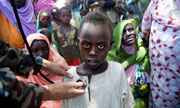 Last week I attended a policy and research conference organized by the UN Office for the Coordination of Humanitarian Affairs (OCHA) in New York. This conference, entitled “Risk, Adaptation and Innovation in Humanitarian Action,” brought together approximately 50 experts mostly drawn from research centers, universities, and think tanks.
Last week I attended a policy and research conference organized by the UN Office for the Coordination of Humanitarian Affairs (OCHA) in New York. This conference, entitled “Risk, Adaptation and Innovation in Humanitarian Action,” brought together approximately 50 experts mostly drawn from research centers, universities, and think tanks.
The participants explored how the current humanitarian system must adapt, innovate, and increase its effectiveness to face growing vulnerability of populations to natural hazards; protracted conflicts and changing forms of violence; and shifts in political and economic powers. In other words, how can the humanitarian system remain relevant in a changing world?
Without doing full justice to two days of intense and rich discussions, some of the main conclusions can be summarized in the five following takeaways:
1. Vulnerability – The weakest link of disaster-prone populations: Climate change and global warming are usually blamed, and rightly so, for more frequent and intense natural disasters and for contributing to an increased humanitarian caseload. Yet, as a participant stated, vulnerability of populations, aggravated by the convergence of multiple trends such as population growth, urbanization, water scarcity, and food price volatility, is “a greater determinant of disaster risk than natural hazards.” Rather than dealing with the effects of humanitarian crises alone, the humanitarian system has no alternative but to address the causes of vulnerability if it wants to face up to the challenge.
2. Expand the campsite: In order to address growing humanitarian needs, the international humanitarian system—which finds its roots mostly in the Western developed world—must better work with and support the capacities of local communities and authorities, affected states, regional institutions, and so-called “non-traditional” actors such as corporations, diasporas, and emerging donors. However, the humanitarian system must operate an attitudinal shift. Rather than bringing other actors to fit into the system, it should look at how it could learn from them to adapt and adjust. Instead of expanding the “humanitarian tent,” as some participants put it, it should invite other campers to set their own tents on the campsite.
3. Risk-aversion prevents innovation and timely action: The humanitarian system has no choice but to innovate if it wants to face growing challenges and increasing humanitarian needs. Yet, innovation implies taking risks—notably financial ones—to which the humanitarian system remains averse. The same holds true for the recurrent failure of early-warning systems: while the technology itself is effective to warn of an impending drought or flood, donors remain wary to invest in preparedness ahead of an expected disaster that might not occur. This requires a change of mentality both within humanitarian agencies and donors, where failure is usually penalized and success, which often implies a degree of risk-taking, is not fairly rewarded.
4. Whither “humanitarian space?” Most participants rejected the continued relevance of the concept of a “shrinking humanitarian space.” Rather than talking about a sacrosanct space that is taken for granted, existing outside the realm of politics and revolving around humanitarian actors’ right to be present in crises areas, one should put affected populations back at the center of the discussion and focus on humanitarian access and acceptance. Humanitarian access, particularly in conflict settings, requires negotiating with relevant parties and accepting some necessary compromises while always weighing the good it can bring to affected populations versus the moral redlines one should not trespass.
5. Toward a “coordinated fragmentation”: Humanitarian actors have comparative advantages and limitations that must be understood and acknowledged: some agencies have the ability to maintain a high degree of independence and neutrality in highly volatile contexts, securing acceptance and access by default to addressing underlying causes of crises, while others deliberately attempt to address the (often inherently political) causes for the greater good, sacrificing in return some degree of independence and neutrality. Better coordination of these humanitarian agencies is highly desirable in theory, but participants agreed that in some cases—notably in extremely insecure contexts—this diversity can be a strength. In some contexts, a degree of “fragmentation” is desirable as it allows agencies to use their comparative advantages most effectively, but coordination and consultation remain necessary at the global level so as to use this diversity in a strategic manner.
To somebody familiar with humanitarian affairs, these discussions would hardly seem groundbreaking. As a participant voiced in the concluding session of the conference, the humanitarian system would benefit from further radical thinking, and still needs to address some of its entrenched contradictions. One example is the irreconcilable nature of the traditional humanitarian principles of independence and neutrality with an approach that increasingly aims to address underlying causes of vulnerability and crises.
However, no revolution ever happened overnight! This conference demonstrated an increased awareness of some of these contradictions and the necessity to adapt to a changing world if the system is not to become obsolete. In this respect, one should welcome the intention of OCHA to further strengthen interactions with policy and research circles by repeating similar events, and to develop a network that would fully involve actors from the global south, where the future of humanitarian action lies.
About the photo: UNAMID conducts a medical campaign in North Darfur, May 2011. UN Photo/Albert Gonzalez Farran




